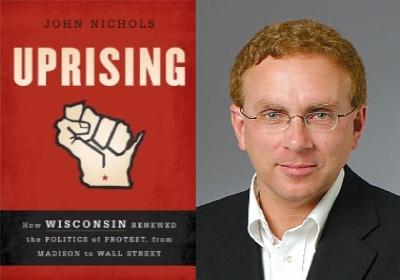Feb 14 2012
Uprising: How Wisconsin Renewed the Politics of Protest, from Madison to Wall Street
Listen to entire program

Democratic lawmakers fled the state to prevent a vote on the legislation from taking place. A diverse array of Wisconsinites turned out to protest day-in and day-out, from students and community supporters to unionized workers from the private and public sectors, including firefighters and police officers. Protesters eventually occupied the capitol building and the world began watching and cheering-on the movement. The protesters were fed by pizza ordered for them by supporters across the US, and from as far away as Egypt. Wisconsinites were not deterred by freezing temperatures and they fought against being locked out of their own capitol building.
On March 10th Republican state legislators defied their opponents and the bill was passed amid cries of “shame” from protestors. Governor Walker signed it into law on March 11th. Protesters brought a legal challenge against the bill and continued demonstrating against it for months, erecting a tent city outside the capitol building which they dubbed “Walkerville.” They remained active in their state’s budget negotiations, agitating against Walker’s extreme conservative agenda. In June 2011 activists changed their focus, mounting an effort to recall Walker and some state legislators. By mid January of this year, over 1 million signatures in support of a gubernatorial recall election were gathered. It is expected that the minimum number of 750,000 signatures will be certified as valid and that Walker will be forced to run for his office again this year. This week protests will be held daily in Madison Wisconsin to mark the movement’s one year anniversary.
Journalist John Nichols, associate editor of the Capitol Times in Madison, Wisconsin and a correspondent for The Nation magazine, chronicled his state’s transformation into the headquarters for the labor movement and the inspiration for protests around the country. Nichols’ surveys a year of popular action in the US in his new, highly anticipated book, aptly named Uprising: How Wisconsin Renewed the Politics of Protest, from Madison to Wall Street. John Nichols’ Uprising is more than a history. In his book he analyses how Wisconsin and Occupy Wall Street revived American dissent and changed our national discourse.
GUEST: John Nichols, associate editor of the Capitol Times in Madison, Wisconsin and a correspondent for The Nation magazine, author of many books including Uprising: How Wisconsin Renewed the Politics of Protest, from Madison to Wall Street
Comments Off on Uprising: How Wisconsin Renewed the Politics of Protest, from Madison to Wall Street




